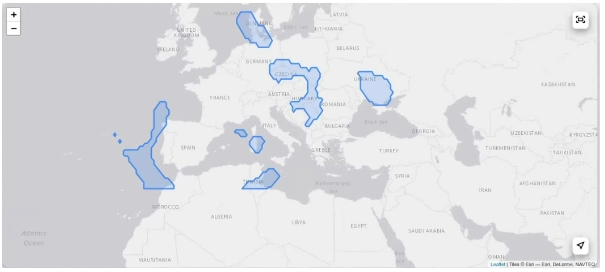A prototype system which warns of natural phenomena dangerous for aviation developed
11/24/22
The ALARM research team, a European scientific project coordinated by Universidad Carlos III de Madrid (UC3M), has developed a new prototype early warning system to monitor natural phenomena that threaten the safety and efficiency of aviation. This system, currently capable of predicting the dispersion of volcanic ash or the progress of certain thunderstorms, also identifies the areas where the passage of aircraft has the greatest impact on climate change.

Image of the prototype interface showing ECHO areas in Europe at a given point in time (the areas where the passage of aircraft has the greatest climate impact by contributing to global warming).
By combining satellite data with weather forecasts, the researchers have managed to improve the spatial and temporal resolution of information on a range of natural phenomena that can jeopardise the safety of aircraft, such as volcanic eruptions, forest fires, sandstorms or electric thunderstorms, for example. Should certain aerosols (smoke, dust, etc.) enter an aircraft engine, they can cause serious damage, both through the erosion and corrosion, as well as through possible obstructions. Volcanic ash and gases produced by volcanic eruptions, such as sulphur dioxide, also pose certain risks, as they can cause abrasions on windscreens, corrosion in engines and various types of damage to aircraft systems and instruments.
"By applying artificial intelligence, we can predict short-term changes to the amount of sulphur dioxide present in the atmosphere and the dynamics of thunderstorms around airports," says Manuel Soler, from UC3M's Department of Aerospace Engineering, who is heading up the project. In fact, within the framework of this project, tests have been carried out with the new prototype at two European airports, Brussels and Milan.
The information provided by this new early warning system is of great help when it comes to decision-making by operators involved in air traffic, such as controllers, pilots and other participants in the aeronautical sector.In the event of an emergency due to natural phenomena, this system will allow them to access information -which has been tailored to their needs - through an interface that displays the data in a simple and intuitive manner. "In the field of artificial intelligence and in the age of data, it can still be difficult to access all the information (which is often very heterogeneous), process it and store it in a way that makes it accessible. This has been the main challenge we have faced in the project," says Manuel Soler.
Another notable and innovative aspect of this project - in which scientists and technology experts from Germany, Belgium, Spain, Italy and the UK have collaborated - lies in the consideration of climate impact as an additional harmful effect. "Although it does not put the safety of the aircraft at risk, it does put the planet at risk," according to the researchers. They have thus been able to identify the areas where the passage of aircraft has the greatest impact on the climate by contributing to global warming.They call these areas 'ECHO areas'. "This tool for identifying and predicting ECHO areas is at an early stage of development but has great potential for use by air network managers and Air Navigation Service providers, allowing them to designate certain areas as 'ecological' and to take certain decisions, such as limiting or regulating traffic therein," adds Manuel Soler. This information could also be passed on to airlines so that they can integrate it into their tools and develop more environmentally friendly flight plans.
As a result of this research, collaborations have been established with other European scientific projects, such as FlyATM4E, focused on optimising trajectories for greener aviation, and ISOBAR, aimed at predicting imbalances between capacity and demand in airspace. These collaborations have led to new lines of research that combine the early warning platform developed by ALARM with other potential features that are of great interest in today's aviation sector, such as fog prediction or the effects of condensation trails (the linear trail of clouds left behind by some flights in certain atmospheric conditions) on climate change.
ALARM (multi-hAzard monitoring and earLywARning) is a project funded by SESAR Joint Undertaking, which is supported by the EU H2020 Programme (GA 891467), and which has been developed over the last two years. It is coordinated by UC3M and involves partners from five European countries: the German Aerospace Centre (DLR), the Royal Belgian Institute for Space Aeronomy (BIRA-IASB), the University of Padua (Italy) and two small companies in the aeronautical sector, the British company SATAVIA and the Italian company SYMOPT.
------------------